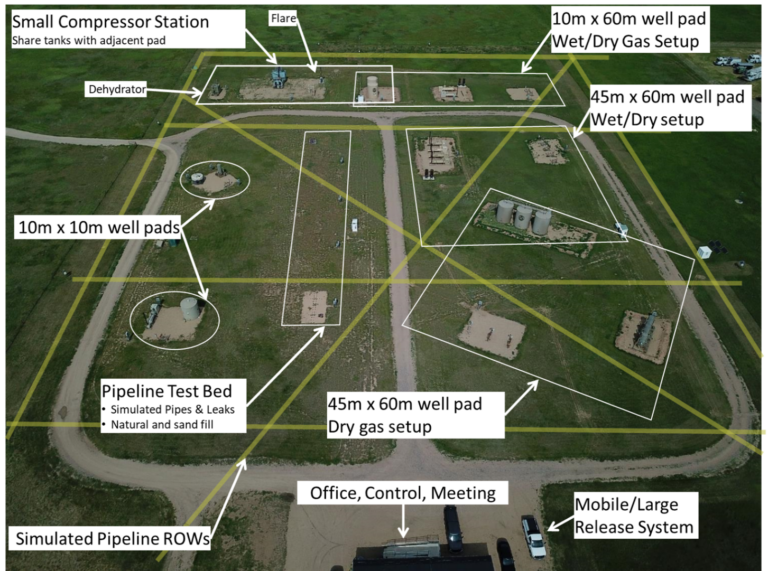METEC Facility
The METEC facility was first developed under the ARPA-E MONITOR program, starting in 2016. The facility has since been extended by subsequent projects and programs, and operates as a self-funded research program.
METEC was originally designed to support the testing of next-generation leak detection & quantification (LDAQ) methods. Many next gen methods rely on wind transport of emissions to allow leak detection from a distance, using point, line, or imaging sensors. To support LDAQ testing, METEC was designed to emulate the emissions behavior and wind transport characteristics of operational upstream and midstream oil and gas (O&G) facilities. The facility supports a range of well pad sizes, some compressor equipment, and associated access roads.

METEC’s equipment is real – donated by members of the METEC IAB – but is not operational. Gas is delivered to leak locations via small-diameter tubing, and equipment has been modified to ‘leak’ in a convincing fashion. Using our extensive field knowledge, we’ve engineered the leak locations to look and feel realistic. Emissions occur where they would in the field, with the variability and rates seen in field studies. As currently configured, METEC has approximately 200 above-ground release points, all of which are remotely controlled, from 6 pads and 4 facility types. Approximately 60 release points can be controlled at any one time.
Adding to the visible equipment is an array of underground resources that emulate natural gas pipelines – both pipeline structures and rights-of-ways (ROWs) with hidden leak locations. We also support one of the only engineered test beds for underground emissions research – a 10×20 meter sand-filled pit, 2 meters deep, with specially engineered underground features for disrupting gas flow. This testbed provides a unique, controllable, facility for developing fundamental models of gas migration. Underground test beds were developed in close cooperation with our long-standing partners at the University of Texas at Arlington.
No test facility is complete without the supporting analytic infrastructure. In addition to CSU’s and Powerhouse’s impressive battery of instrumentation, METEC hosts an array of analytic and practical instrumentation targeted at natural gas emissions, including:
- Mobile / large volume gas release rig
- Tunable wet gas releases
- Trace gas analyzers
- Gas chromatograph
- Meteorological stations – fixed and mobile
- 6 networked OGI Cameras for imaging research
